designpicture booksmovieprocess
previous1234next
3. Idea of toys for reducing anxiety in children
Through the visit to the Astrid Lindgren Children’s Hospital, I knew that the act of play was very important for children to understand things. Since I learned that children could reduce their anxiety by getting to know what they would experience from now on, I began to think of making something that release them from uneasiness caused by the unfamiliarity they feel in hospitals.
The first idea came into my mind was to make a thing like a doll house which was composed of various kinds of rooms in hospital, so that it can help children to imagine what would happen in each room and talk with their family and nursing staffs about it. It was to change the image of hospital in their mind from unknown place to a place slightly familiar with by looking into the world behind the doors that they have never opened. I thought besides, if the toys were provided with a picture book or something to tell about why we go to it and what we do there, it would give more concrete images about hospital and could be more effective to enhance their understanding before they start playing with the dolls. I realized, however, that I could not determine how far details my product should express. And so, I decided to consult experts such as pediatricians and clinical psychologists over my idea and ask their opinion.
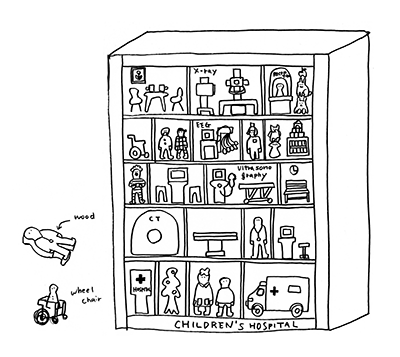
4. Opinions from the people working in the actual situations
With rough sketches on my original idea, I visited a pediatrician, a clinical psychologist, a childcare worker and mothers of young children to ask about what worries and troubles the children and how they tend to behave when they go to a hospital.
Advice from a pediatrician: Children really need to know is about what actually may happen to them.
First of all, I asked to the pediatrician how she explains about treatments to her child patients usually. According to this doctor, if the patients are 3 to 6 years old, it may be difficult to understand clearly the examinations and operations, and most children under 3 years old cannot understand names and functions of organs at all. In case of children over 5 to 6 years old, however, some of them can understand such things. This doctor is an expert of diseases of blood and oncology, and she makes it a rule to explain the disease to the child if he or she is over 5 years old. Even if they cannot understand enough the matters, she would do so because she needs their cooperation during the medical treatment.
Regarding the contents of my picture book, she found several difficult descriptions about functions of body and medical procedures, and gave me an advice that their most concerned points about the medical treatments in common are what happens to them actually such as the treatment finishes soon? It is painful? Or the parents can be together? She advised me also that in order to perform the procedure smoothly, unnecessary fears must be removed as far as possible. It is good for hospital doctors and stuffs to let children understand that painless things are not actually painful. Even if the treatments are painful, they should not tell that they are not painful.
How to express difficult words such as names of body parts: We replace difficult words by ones that children can understand.
If I talk to a child patient, I translate difficult words such as names of body parts into the words even children can understand. For example, Shinzo (heart) is an unfamiliar word for them, so I express it as ‘the part beating in your breast’. A stethoscope is called ‘Hello-hello’ because it looks like a phone. An injection which most small children already have known and hate can be called ‘Chikkun!’(a prick sound with a needle in Japanese) and the X-ray can be expressed as ‘taking a picture by camera’.
The attitude of children during a medical procedure: If the patients are under 4 years old, most of them are likely to cry with tears soon.
Because children are already sick and in a bad mood when they get examinations at the hospital, most patients under 4 years old, are likely to cry with tears soon. Especially, if the child already experienced a pain by blood sampling or injections in past or if he or she is afraid of strangers, they tend to burst into tears even only by entering the consultation room. There are also many children who begin crying out just by being separated from arms of a parent. Examinations like X-ray procedure can be done in a few seconds. However, since these examinations are done by him or herself, it would be better to inform them what would happen during the time by using a toy or something beforehand.
About the attendance during the examinations: For some examinations, children have to take by him or herself. In fact, in most cases, the examinations are done without attendance of parents.
If the parents stand by the child during medical treatment, he or she can be very relieved. However, for some diagnoses, they have to take it alone. For example, in case of Electro Cardiograph, parents are always allowed to attend the child, but when it comes to CT or X-ray, children are expected to have them alone because the procedure causes unwanted risk of radiation exposure to the attendants. So, usually, those radioactive examinations are done leaving the parents in the next room where they can show only their faces to the child through the window. If the mother is not pregnant, she may accompany the child with wearing a protector. In case of CT examination while the child examinee is waking, parents or medical staffs would attend. In fact, doctors are likely to accompany more than parents in this situation. When an adult patient is administered a contrast medium for CT examination, usually a radiologist gives him or her injection in the examination room of the radiology department. However if the patient is 3 to 6 years old, since radiologists are inexperienced at the treatment of young children, a pediatrician gives him or her an injection before entering the examination room. Then, contrast medium is provided by the drip infusion line during the examination. In case of outpatient, contrast agent is not used usually.
Which treatment does need a play preparation?: Play preparation is needed for the examinations which are hard to explain in words, such as X-ray, CT, Electro Cardiograph and Echographic examination.
There are various kinds of medical examinations and treatments, such as Blood sampling, Bone marrow examination, Lumbar puncture, Kidney function test, Spirometry, Polysomnography, Catheter, Anesthesia and so on. Among them, injection is known well by many children because they have experienced as getting vaccine, but examinations such as X-ray, CT, Electro Cardiograph are not well-known and not easy to explain in words, and so I want to have something to explain about them clear. In terms of Electro Cardiograph, I suppose, if you make something like tips of wires which can be stuck to dolls, it may help children to image what ECG is. About the Echographic examination, it is also operated so often for child patients as to need play preparation. But when it comes to brain wave detection, the play preparation may not be necessary because it is often done while children are sleeping with sleeping pills.
Opinions from a clinical psychologist
About the hospital staffs appeared in the picture book: ‘Please keep in mind that there are more various kinds of experts that children will meet in the hospital.’
“If you are to realize the idea in a form of product or something in the end, although I don’t know how far you should express the situation in hospitals, I wish you to keep in mind that there are more various kinds of experts that children will actually meet in the hospital; besides doctors and nurses, clinical examiners, physical therapists, dietician and clinical psychologists and so on.
About the focal point of your product and picture book: I think children in need of long-term medical treatment due to illness are the persons who have to understand the situation that they are placed in.
In terms of the difficulty level of the picture book you made, I thought the text was a bit long and difficult for children 3 to 6 years old that you intended for. If your purpose is to explain how the inspection tools function, it would be better to focus on what the tools can make more simply and just attach pictures or something to give images of the situations. Or, why don’t you just narrow down to some specific diseases that occur often to young patients, for example, type 1 diabetes or heart diseases, and focus on explaining what kind of treatments are required for these diseases and how the treatments are done during the examination? I think that children in need of long-term medical treatment due to illness such as chronic illness or intractable diseases are the persons who have to gain this kind of knowledges, and so there would be more needs for it from medical staffs.
About the story of the picture book: Not every child can see the happy ending.
In terms of the story of the picture book, I thought the instruments that appeared there were exaggerated too much and not match to the simple illnesses that you told in the story; for example, the story about stomachache by eating a rotten food. The story of your picture book finishes with happy ending, but the children with chronic illness or intractable diseases cannot always see the happy ending. So they may possibly feel sad if their cases are not meant to be as your story goes. It depends on what types of children you will intend for, but you should concern that there are children who are placed in the situation of living linger with illness.
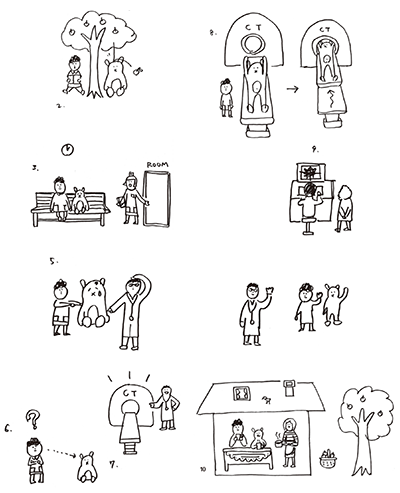
Advice from a childcare worker
Children’s play changes by ages: Children start playing alone when they become 2 years old, and after 3 years old, they start pretending play with friends.
It differs from person to person, but I can say that the way of playing is different between the children of 2 to 3 years old. Most children of 2 years old play alone. They play with the things they are simply interested in, so some likes just holding a stuffed animal and some like climbing higher places such as steps. I have also seen some like playing house and some like playing with a toy of train without getting bored. Besides, 2-year-old children have a tendency of repeating a same thing in play. When they become 3 years old, they start pretending play of heroes or family members more often because they start playing with friends from around 3 years old. They start using toys with purposes. For example, if children become 3 years old, it is seen that they start pretending mum or dad in play with likening a staffed animal to a baby, giving it a ride on their back and putting it to bed, while they could have been satisfied by holding stuffed animals when they were 2 years old.
Q. How far can children understand about hospital?
A. It seems children can recognize hospital more clearly after they become 3 years old
When children become 2 years old, they start recognizing the place called hospital, but the degree of their understandings are still very rough like they just have an image that ‘hospital = a place to get injection = a scary place’. 3-year-old children still would have an image that hospital is a scary place and so they might not like hospitals, yet some of them also can understand more clearly that the hospital is the place where you go if you become ill and it’s the place to receive medicine to care yourself. Moreover, some of them become able to understand the image of death, and so I have seen that some 3-year-old children talked to me about their grandfather or grandmother’s death. After they become older than 4 years old, they acquire a basic comprehensive faculty to communicate with adults, and so their recognition about hospital would become much clearer.
Q. How do you think of the picture book that I made as a prototype?
A. I cannot say how the difficulty level of the picture book should be and how the comprehensive faculty of children will be like since it differs from person to person.
The picture book that contains explanations of various kinds of medical instruments looks good for children 5 to 6 years old, because they can understand it. But if you focus on children of 3 to 4 years old, I think they can only understand that CT is the machine to see the head but they cannot remember names of the instruments. I suppose they even cannot recognize the letters ‘CT’ itself (because Japanese children are not familiar with English letters). Also, I can imagine the possibilities that the children who hate hospitals originally would be afraid more by looking at the picture book. On the contrary, I think some children rather can be relieved because of it. So, I cannot say what is good or bad since the comprehensive faculty of children differs from person to person.
Q. Do children feel like playing with unfamiliar things for them?
A. Yes, they do. Children can play freely with anything around them. However, some of them are tend to get bored with them soon.
Basically, I can say that children can play with anything. Whenever I go to a park with grass and without playground equipment together with children, they start playing freely with anything such as fallen twigs, leaves and seeds. I have often seen that they start pretending play of cooking with leaves as rice and twigs as chopsticks or they can have fun even just by collecting seeds and holding them in hands. Their way of playing is very flexible. On the other hand, some children are very fickle, and so if the toy or picture book does not match to his or her age, they get tired of them easily. So, I have to say children also have such an aspect of being fickle.
Advice from a mother who has a 3-year-old child with experiences of CT examination
Q. How was your daughter when she had CT examinations?
A. It was very hard for her when a nurse tried to set the drip infusion because the nurse had tried to give her injections again and again. For the first time of the CT examination, she cried out, and even for the second time, she got slightly nerves.
My daughter has been hospitalized for ten days due to the RS virus. She experienced CT examination at the time. Because she suffered from dyspnea, she wore a respirator and was connected with a drip during the time. When a nurse tried to set a drip infusion to her, because the veins of such small children were too thin, the nurse struggled with pricking a blood vessel, and so I remember that my daughter was pricked injections on her arm again and again. Another time, she had an accident of falling off stairs when she was playing with a tricycle, and so she had to get a CT scan of her head again. For the first time she had a CT examination, she wept and cried out because her head was hold to the bed while she did not understand the situation. For the second time, she was rather calm since she grew up and had known it. Yet she looked being frozen, so I got she was still nerves.
Q. How do you encourage your daughter when she gets an examination or a treatment?
A. I think I have no choice but to let her cry because she is already feeling bad from illness. I divert her unpleasant feelings toward treatments by making a promise of giving her favorite sweets or something later.
Since my daughter had an experience of hospitalization, she has never cried by usual visit to hospitals any more. It looks rather like she wishes to see a doctor to get a sweet medicine. On the other hand, whenever she has an examination while she feels bodily pain, she cries no matter what I say. When she suffered a dislocation of an arm, I tried to divert and convince her by saying that I will give you your favorite sweet after the treatment.
Q. How do you spend the waiting time at a hospital?
A. It is very hard for us to wait at the emergency department in a hospital since it takes long time and there is nothing to play with. There are some toys in the play corner of pediatrics, but I’m afraid of the hygiene of them.
The situation of waiting time differs depending on clinic or hospital. Basically, if a child becomes sick, you have to go to a clinic in your town at first. There, the child is diagnosed if he or she needs more detailed inspections, and you will be given an introductory letter to go to a hospital. If you go to a doctor on Sunday or holidays, you have to go to the emergency department of hospital instead of clinic. In this case, because you don’t have an introductory letter to see a doctor immediately, you will have to wait there for more than 2 hours in normal.
If we have to go to a doctor, we go to a pediatric hospital. Pediatric hospital has a play corner for kids. They have picture books, but my daughter prefers playing with blocks and kitchen toys. There are so many stuffed animals too, but I am afraid of their hygiene since they are used by children who may have various kinds of virus. For example, the RS virus that my daughter had was very common among young children in winter, and the virus causes pneumonia in those children.
When we went to a dentist, we saw many picture books about decayed teeth there. Since I read some of them for my daughter, she became frightened of being opened a hall in her teeth with a drill by dentist, and so she started brushing teeth by herself. We also have been to a dentist which has a slider in the waiting room. Waiting time at hospitals is a big matter for us. Because children are not main user for hospital basically, their waiting rooms are quiet and have nothing for children to play with. When I went to a hospital in countryside, there was a kids’ play corner where kids cars, toys and picture books were prepared but the variation of them was poor compared to other usual pediatric hospitals. Their lineup did not look enough to satisfy children. The three hospitals I have ever been to in Tokyo had some picture books, but did not have kids’ play corner. When I went to the emergency department in a hospital, we had to wait two hours at a lobby where no toys were prepared. So my daughter killed time running about in the room or climbing a couch up and down. She also played in exploring in the hospital with saying ‘here is an elevator’, reading the numbers put on the reception counter, ‘this is No.4, but where is No.5? Other parents sitting nearby us seemed to have known this situation beforehand, and they brought favorite toys or picture books from home.
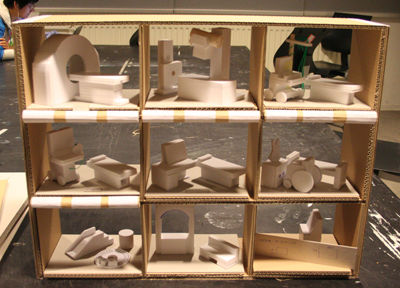
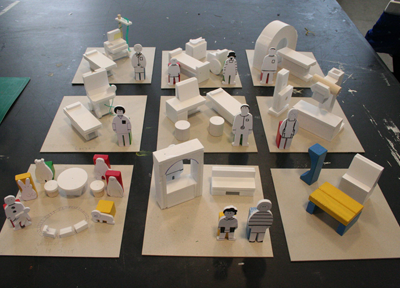
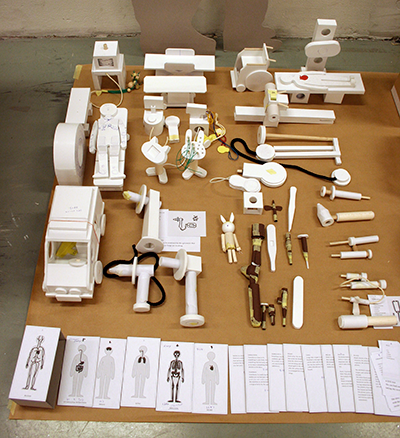
3. 子供の不安を和らげるおもちゃのアイデア
アストリッド・リンドグレーン子供病院の訪問を通して、「遊ぶ」という行為が子供にとって物事を理解する手段として大切であることを知りました。また、病院でこれから自分が経験することを知ることで、子供は心の不安を和らげることができるということを知り、子供が病院で感じる「見えにくさ、親しみにくさ」からもたらされる不安を少しでも取り除けるようなものを作りたいと考え始めました。
最初に思い浮かんだアイデアは、病院内の様々な部屋を表現した人形の家のようなものを作り、子供が遊びながらそれぞれの部屋でどんなことが起こっているのか想像したり、それを使って家族や病院スタッフと話ができるようにするというものでした。それは、これまで開ける事がなかった扉の内側の世界を見る事で、病院を知らない場所から、少し知っている場所に変えるというアイデアでした。また、そのおもちゃに、なぜ病院へ行くのか、そこでどんなことをするのかという物語の絵本をつけて、子供が人形遊びを始める時に少し具体的なイメージを与えれば効果的なのでは?と考えました。しかし私は、どれほど詳細に表現するべきか自分で判断するのは難しいと感じたため、このアイデアを小児科の医師や臨床心理士など、現場で活動する人々に見せ、意見をもらうことにしました。
4. 現場に携わる人々の意見
最初の案を簡単なスケッチにまとめたものを持って、小児科の医師、臨床心理士、保育士、子供の母親へ、病院へ行く時に感じる心配や手間のかかっていること、子供の様子について伺うことにしました。
小児科の医師からの意見
子供にとって本当に必要な情報は、具体的に自分の身に起こることなのでは?
小児科の医師にはまず、普段どのように子供の患者に処置の説明をしているのかということから聞いてみました。この医師によると、5−6歳になると数人の子供は臓器の名前と機能を理解できるようになるものの、まだ具体的な検査や手術を理解させるのは難しいと感じるため、普段は子供の理解力に応じて度合いを変えて処置の説明をしているとのことでした。ただ、この医師はこの血液の病気や腫瘍が専門であり、それらの治療には本人の協力が必要になるため、幼稚園以上の子供に対しては例え全てが理解されないとしても必ず説明をするようにしているとのことでした。
私の絵本の内容については、身体の機能や処置の方法など少し難しい部分があることについて、子供たちに共通して大切なことは、処置にどのくらい時間がかかるのか、処置の間そばにお母さんやお父さんがいてくれるのか、痛いのかといった「具体的に自分の身におこること」についてなのではないか? という意見をもらいました。また、検査や処置をスムーズに行うには、恐怖心がとても強い子供から、少しでも不要な恐怖心を取り除くことが重要であるため、痛い検査や処置を痛くないと説明すべきではないが、痛くないことを痛くないと理解してもらうことはとても大切だと指摘されました。
身体の名称など難しい言葉の表現について
難しい言葉は、子供の言葉に置き換えて伝える
子供の患者に声をかける時、身体の名称など難しい言葉は、子供に伝わりやすい言葉で表現し直している。例えば「心臓」は小さな子供に馴染みのない言葉なので「おむねのドキドキするところ」、聴診器は「もしもし」、注射は怖いものなので小さな子供もよく覚えている器具で呼び名は 「ちっくん」、レントゲンは「おしゃしんをとる」と表現している。
処置中の子供の様子
4歳以下の子供の多くが泣きだしてしまう
検査する時点ですでに具合が悪いということもあり、4歳以下の子供の場合、処置の際大泣きしてしまう子供がたくさんいる。特に、人見知りをする子供や過去に採血などで痛い思いをした子供は、診察室に入っただけで泣いてしまうことがある。また、親のだっこから引き離されることで泣き始める子供もたくさんいる。レントゲンなど、処置自体は一瞬で終るものの、部屋にひとりにされ心細くなるような検査には、おもちゃ等で何をするか教えてあげられたら良いと思う。
検査中の付き添いについて
検査項目によっては、子供ひとりで挑むことになる検査もある。実は親が離れて行われる場合が多い
処置の間、親がすぐそばにいれば子供はとても安心する。しかし検査項目によっては、一人で臨まなければいけないものもある。例えば、心電図は親の付き添いが可能だが、CTやレントゲンは被爆のリスクがあるため、可能であれば子供ひとりで検査を行うことが本来は望まれる。
通常は親が隣の部屋から顔を見せる形で検査を行う場合が多く、もし親が妊娠などしていなければ、プロテクターをつけて付き添うこともできる。 CT検査は被験者の子供が覚醒した状態で検査する場合は、大半の場合は親や医療者などが付き添うことになる。実際、医師が付き添う場合が非常に多い。
CT検査で成人に造影剤を投与する際、検査室で放射線科の医師が注射を行うことになるが、3−6歳の子供の場合は、放射線科の医師が小児の処置に不慣れであることを考慮し、検査室に入る前に小児の医師が点滴ルートをとることになる。造影剤は検査中に点滴のラインに入れられる。外来で検査をする場合は造影はしないことが多い。
どの処置にプリパレーションが必要か
レントゲン、CT検査、心電図、超音波エコーなど、言葉ではイメージしにくい検査に必要となる。
医療検査、処置には血液検査、骨髄検査、腰椎穿刺、腎機能検査、肺活量測定、睡眠ポリグラフ検査、カテーテル、麻酔など様々な物がある。そのうち、注射はワクチンなどの経験で大抵の子供は知っているものだが、レントゲンやCT、心電図など、言葉だけではイメージしにくい検査についてわかりやすいものがほしい。心電図は、人形にワイヤーの先がぺたぺたとくっつくものができればよりイメージしやすくなるのではないか?また、超音波エコーも子供の患者によく行う検査であり、脳波については3−6歳であれば薬で寝かせて検査を行うことが多いので、必要がなさそうだ。
臨床心理士からの意見
絵本に登場する病院のスタッフについて。子供が病院であらゆる専門のスタッフに出会うことを心に留めてほしい。
(プロダクトなど最終的に形にする際に)どこまで病院の状況を表現するべきか分からないが、実際病院で子供が出会うスタッフには、検査技師や運動療法士、栄養指導士、臨床心理士など医師と看護師以外にも色々いるということにも心を留めておいてほしい。
プロダクトや絵本の焦点について
長く病気と付き合っていかなければならない疾患の子供こそ、自分の置かれた状況を把握する必要があると思う。
(試作の)絵本の難易度について、3~6歳対象にしては文章がやや長くて難しいように思った。検査器具の働きを説明するのが目的なのであれば、もう少しシンプルにその検査器具が何をするのかという内容に絞り、イメージがつかめるような絵なり説明があればよいと思う。あるいは、例えば、若年で発症することの多い1型糖尿病や心疾患などいくつかの病気にしぼり、その病気にはどういった検査が必要で、検査中でどのようなことをするのかを説明することに焦点を当ててはどうか。長く病気と付き合っていかなければならない慢性疾患あるいは難治性疾患の子どもこそ、そういった知識を得る必要性があるし、医療者からのニーズもあると思う。
絵本のストーリーについて
どの子供たちにもハッピーエンディングが訪れるわけではない。
絵本の内容について、病気自体は素朴(腐ったものを食べて腹痛になるなど)であるわりに、出てくる機器が大仰であるような気がする。(試作の)絵本では物語がハッピーエンドで終わっているが、実際には(先に挙げたような)慢性疾患・難治性疾患の子どもたちはハッピーエンディングでは終われないので、自分はこの物語の通りにはいかないという悲しさを感じてしまう可能性があるかもしれない。どんな子供を対象とするかにもよるが、病気を抱えながら生きていくという状況の子供もいるので配慮が必要。
保育士からの意見
年齢によって変化する子供の遊び方
2歳になると一人遊び、3歳になると友達と一緒にごっこ遊びをし始める。
個人差はあるが、2才と3才では遊び方が異なる。2才は1人遊びが多いように思う。興味のあるもので遊ぶため、ぬいぐるみなどをただ持っている事がよかったり、階段など高い所が好きだったり、おままごとが好きな子供もいれば、電車のおもちゃでずっと遊んでいたりする子供もいる。また、2歳児は繰り返して遊ぶ傾向がある。3才になると友達と遊ぶようになるため、ごっこ遊びや、ヒーローになりきったりする遊びが多くなる。おもちゃも目的のある使い方をするようになる。例えば、2才の時はぬいぐるみをただ持っていることで満足していたのが、3才になると、ぬいぐるみを子供に見たてて、おんぶをしたり、ふとんに寝かせたりと、自分が親のようになって遊ぶ姿が見られるようになる。
子供のごっこ遊び
子供は3才ぐらいから人の真似をし始める傾向があるように思われる。はっきりした理由はわからないが、おそらく周囲の状況が理解できるようになってくるため、人の役割や職業について興味を持ち始めるのだと思える。
病院について子供はどれほど理解力しているか?
3歳くらいから病院を具体的に認識できるようになるようだ。
2歳くらいになると子供も病院という場所を認識するようになる。病院 = 注射をされる所 = 怖い場所という大まかな印象を持つ程度だと思われる。3才でも病院は怖い場所というイメージがあり、好きな場所ではないとは思われるが、「病院は具合が悪くなると行く所で、お薬をもらって治す場所」というように具体的に認識できる子供が増える。さらに、「死ぬ」というイメージも理解するようになるようで、おばあちゃんやおじいちゃんが亡くなったことなど、話をしてくれる子もいる。年齢が4才を超えると、大人と対等に話せる程の基本的な理解力を身につけるようになるため、病院についての認識はだいぶ明快になるようだ。
試作の絵本についてどう思うか?
内容の難易度と子供の年齢による理解度は個人差があるので、一概にこうであるとは言えない。
色々な医療器具についての説明が入った絵本は、5、6歳の子供であれば理解できるのでその年齢には良さそうに思う。3、4歳を対象にすると、機械の名前などは覚えきれず、例えばCTは頭を見る機械という程度までの理解になると思える。CTという言葉自体が理解できない事も考えられる。また病院が嫌いな子供にとっては、絵本を見る事で怖がって、さらに病院嫌いになってしまう可能性もあるだろう。ただ、逆に安心する子供もいると思う。子供の理解については個人差があるため、何が正しく、何は間違っていると一概には言えない。
親しみのないものでも子供は遊びたくなるのだろうか?
子供たちはその場にあるもので自由に遊び始めることができる。ただし、すぐに飽きてしまうことも多い。
基本的に、子供たちはどんなものを使ってでも遊べると言える。子供たちと芝生だけがあるような遊具がない公園に出かけると、彼らは落ちている枝や葉っぱ、実などで自由に遊び始める。いつのまにか葉っぱをご飯に見立てて枝をお箸のようにして、料理ごっこを始めたり、実を拾ってそれを手に持っているだけで楽しんでいたりする姿を見かける。子供の遊び方は柔軟だ。ただ、飽き性の子供もいるため、その子供の年齢に合わないおもちゃや絵本だったりするとちょっと遊んで、遊ばなくなることもあると思われる。子供にはそのような気まぐれな部分がある。
CT検査の経験をもつ3歳児の母親からの意見
CT検査を受けた時、子供はどんな様子だったか?
点滴ルートをとる際に何度も注射されてて大変だった。1度目の検査では大泣き、2度目では少し緊張した様子だった。
私の娘はRSウイルスで10日間入院し、その際にCT検査を受けることになった。呼吸困難に陥ったので、その間娘は呼吸器をつけ常に点滴がつなげられていた。点滴をつなげる時、小さい子供の血管が細いのでうまく取れないようで、腕に何度も注射を刺されていたのを覚えている。また別の時に三輪車ごと階段から転ぶハプニングを起こし、再び頭のCTスキャン撮ることになった。初めてのCT検査では状況が分からない中、頭を押さえられて行われ娘はひどく泣いたが、2回目の時は、成長し大きくなっていたので落ち着いた様子だった。ただ、姿勢は固まっていたので緊張していたようだった。
検査や処置をする時、どのように子供を勇気づけているか?
調子の悪い時に泣いてしまうのは仕方がないと思う。お菓子をあげるなどの約束をして気を紛らわせている。
娘は入院した経験があるので、普通の医者問診程度では泣かなくなった。むしろ、医者に行って美味しい薬もらいたいな、という様子でさえある。ただ身体が痛い状態で検査をする時は、何を言っても泣いてしまう。最近、腕を脱臼したのだがその時は「後でお菓子あげるよ」と言って落ち着かせた。
病院でどのように待ち時間の過ごしているか?
救命救急科の待ち時間は長くて、遊ぶものもなくて大変。小児病院のキッズコーナーのおもちゃは衛生が不安。
町医者か病院かによって待ち時間の状況は異なる。基本的に、子供が病気になってまず行くのが町医者。そこの診断で、さらに詳しく検査が必要となれば紹介状もらい病院へ行く事になる。日祝日は医者が休みのため、救命救急科がある病院へ行く事になる。その場合は紹介状がないため、通常2時間は待つことになる。町医者にかかる場合は小児科に行くが、そこにはキッズコーナーがある。絵本もあるが、私の娘は本を読むよりも、キッズコーナーのブロック、キッチンセットで遊ぶのが好きなようだ。そこにはとてもたくさんのぬいぐるみがあるのだが、病院には様々なウイルスを持った子供がいるので、それらの衛生については不安を感じる。例えば娘がかかったRSウイルスは、冬は子どもがよくかかるものであるし、小さな子どもはそのために肺炎をこじらすことが多い。
歯医者には虫歯関連の絵本が沢山置いてあり、それらを何冊も読んで聞かせたおかげで、ドリルで歯を開けられたくない恐怖心も煽られ、自分で歯を磨くようになった。滑り台のある歯医者にも行ったことがある。待ち時間についての問題は病院で、基本的に小児を対象としていないため、待ち合い室は閑散としている。地方の病院にはキッズコーナーがあり、子供の乗り物やオモチャ、絵本があったが、小児科に比べて取り揃え方がいまいちだった。子供が満足できるラインナップでないように思えた。私が行ったことのある東京の病院(3か所)は、たしかキッズコーナーはなく、絵本が何冊かあった程度だった。病院の救命救急科に行った時は、おもちゃのないロビーで2時間待たされるため、娘はその場を走り回ったり、椅子によじ登ったり降りたりなどして暇つぶしをしていた。あとは、「ここにエレベーターがあるね」「これは4番(受付や会計口の上に置いてある番号)だね、5番はどこにあるかな?」など、病院内を探検したりして遊んでいた。周りにいた病院通いに慣れている親は、家からお気に入りのオモチャや絵本を持ってきているようだった。
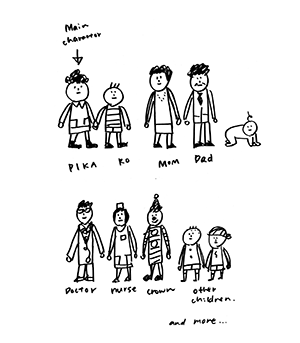
previous
1
2
3
4
next